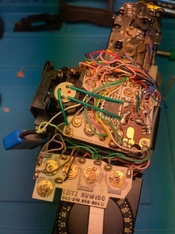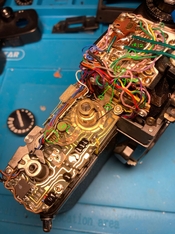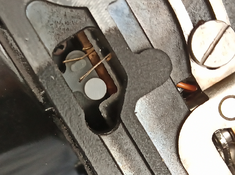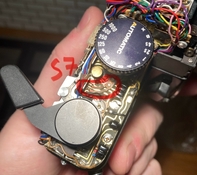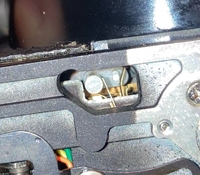Yes it is analog calculation.
Shutter openning time is controled by C2 charge duration (associated with M5128K and the integrated two switching circuit to manage short exposure and long exposure).
In Manual electronic speed, C2 charge duration is controled trough Rt. Rt value is selected with the speed knobe.
C2 charge start when S4 is closed (synchronous with 1curtain start). The charg is negativ (start from +3V going to 0). At the beginning, Uc2 is 0V)
IC1 M5128 detect the C2 charg level comparing voltage at pin 10 and 8 with trigger level at pin 6.
When the charge voltage is crossing the trigger level pin 6, the First switching, delay and second switching circuit of IC1 M5128 control the magnet to releasethe second curtain.
In automatic, the condensator C2 will be charg with a current delivered by Tr12 (located in ICM5129K managing the cells and meter) associated with C1.
C1 condensator is charge with a voltage proportional to light measured by the cells.
I consider the cells bridge as one: Spot or Integral. The output is pin 2m (spot or integral selector).
The Cells bridge deliver a voltage Uev in direct relation to EV (take into account Light level, ASA, Aperture simulation). The voltage charg the capacitor C1.
Near 600mV for 1/30, 18mv per EV (+ for higher speed or minus for lower speed)
C1 is a memory capacitor (the big one, connected with 2 wire to PCB A (on top)).
It is used to memorize the light level when you take a picture: the miror will be up and no light on cells. The light is always memorized (on spot or Integral).
Now you take a picture, you look in viewfinder, the light is measured and bridge output 2m is connected to:
- Meter, via pin 6 of IC M5129K, output amplifier pin 11 go to meter via switch 4m/4a and S"2.
- C1 to charg capacitor.
When out press the release button (body ON, film advance completed)
1) This button open S2 the current light level Uev is memorized in C1
2) You continue to press, S3 is open, S5 is closed, Electronic control of the shutter is on, magnet is on (same step as in manual electronic speed)
3) You continue to press and the mirror start, when up, it start the shutter: first curtain start travel and at same time, S4 is closed (S'4 closed when armed).
Closing S4 start the charge of C2: C1 charge current is delivered by Tr12, Ic proportional to Ib produced by Uev voltage stored in C1 and applied at M5129K input pin 6.
When C2 charge is sufficient ( crossing trigger voltage of IC1 M5128K) it control the magnet through First switching, delay and second switching circuit of IC1 M5128.
Important:
To adjust the speed in Automatic mode : speeds must be accurate using Manual speed selection (adjusting R12 for high speed and R10 for long time exposure)
Then in automatique you have to adjust the step of 18mV per EV and Uev value for 1/30. High and low speed will be OK. If not have to check again everything.
Minolta XE Adjusment method is applicable taking care that Uev have to potentiometer:
alignment for spot measure: R25
alignment for Integral: R5 (this is XE)
Reminder:
To check speed:
1) check mecanical speed X, curtain speed in X and B mode (curtain will be lower due to age) -> Minolta XE documentation applicable
2) check Manual speed : they are electricaly controlled -> Minolta XE applicable
3) check Automatic mode:
a) Cell bridge current ( Minolta XE documentation applicable to adjust R1 an R2)
b) Bridge adustement Spot, R24, R23 and R22 (Specific to Leica but based on Minolta XE method; adjustment of R24 (Rp) is different)
c) Speed alignment Spot R25 (using Minolta XE method at 1/30)
d) Meter alignment for Spot (using Minolta XE method at 1/30)
b) Bridge adustement Integral R21, RL and RS (Specific to Leica but based on XE Minolta method; adjustment of Rp is different, calculation is the same)
c) Speed alignment Integral R5 (using Minolta XE method at 1/30)
That's all...



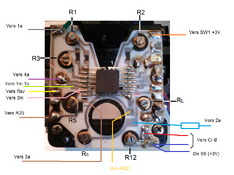
 . I believe that what i circled is S7 and check the wires of PCB1 pin 4&5. At some point i though, maybe there is just dirt somewhere, so i sprayed it with isopropyl alcohol a little and blew it dry. Then the auto mode fired fast, but B and X got stuck when fired. Now i'm back to square one. Firing at mechanical speed at all speeds... I'm getting a bit done with this one. When i got the camera, this was the same problem. Firing at 'x' at all speeds except 'B'. Then i managed to take the front partially off and clean the magnets with a toothpick with isopropyl, and the manual speeds worked since then. But now it's all mechanical again. To take the front off was already such a hassle and a miracle i managed to put it back together that i'm doubting if i want to try that again. I'm almost considering asking if i can send it to you in France
. I believe that what i circled is S7 and check the wires of PCB1 pin 4&5. At some point i though, maybe there is just dirt somewhere, so i sprayed it with isopropyl alcohol a little and blew it dry. Then the auto mode fired fast, but B and X got stuck when fired. Now i'm back to square one. Firing at mechanical speed at all speeds... I'm getting a bit done with this one. When i got the camera, this was the same problem. Firing at 'x' at all speeds except 'B'. Then i managed to take the front partially off and clean the magnets with a toothpick with isopropyl, and the manual speeds worked since then. But now it's all mechanical again. To take the front off was already such a hassle and a miracle i managed to put it back together that i'm doubting if i want to try that again. I'm almost considering asking if i can send it to you in France 